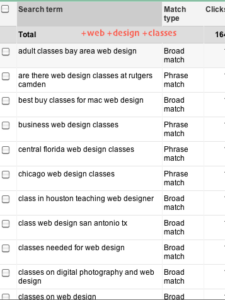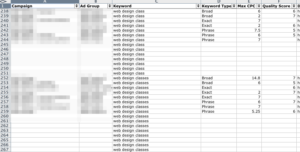Let’s face it: PPC management is an ever-changing business. Managers and agencies come and go, accounts expand and shrink, and before you know it seven different people have had a hand in the evolution of an account. How many of the accounts that you currently manage did you begin? How many of your little PPC babies, whose campaigns and ad groups and keywords you lovingly crafted with your own hands, have gone off to make their own way in the world? The situation is, we all have different campaign structure ideas and management practices. It’s okay! One of the fun things about PPC management is that a lot of techniques work, and inheriting accounts can expand your understanding of others’ strategies. However, account inheritance can also lead to lots of confusion, which is why we’ve written previously about how to intelligently transition PPC accounts.
One of the most insidious problems- especially if a lot of different people have done keyword expansion across multiple campaigns, or if you have yourself and not kept things exceptionally organized- is that there can be duplicate keywords all over the place and you don’t know how they’re affecting each other. Google tells us that if you have duplicate keywords competing for the same bid auction, you have the potential to drive up your own cost, and that sounds unpleasant. But is that phrase match keyword in Campaign X affecting the performance of the same broad match keyword in Campaign Z? How can you know for sure?
There are a few things that influence whether or not your duplicate keywords are really competing with each other and whether or not it’s functionally a big problem for your account, so let’s review them:
Geotargeting:
If two campaigns are geotargeted to two completely separate areas, great! You can have as many duplicate keywords as you want in those two campaigns and they’re not going to compete with each other. However, of course, if you do have areas that are simultaneously geotargeted by more than one campaign, any duplicates are going to compete with each other in the overlapping targeted areas.
Match type:
Technically, the broad match keyword “blue shoes” and exact match keyword “blue shoes” aren’t duplicates. But especially with the release of modified broad matching (a sort of phrase match-broad match hybrid), this doesn’t mean they’re not competing with one another. Keywords with different match types can influence each other’s performance, and it’s not very easy to quantify that impact.
If you look at search queries (click “see search terms” in the AdWords interface) for broad match keywords for which you also have phrase and exact match versions active, you’ll see that occasionally your broad match keyword gets credited with a search query that is listed as “phrase match” or “exact match” because of the way that Google’s magical bidding and ad serving algorithm works. It’s just going to happen, and the addition of modified broad match has made things even more confusing, as these keywords get credited with matching both phrase and broad match queries regularly (see below). They’re sort of competing with everybody. As such, if you’re going to be considering duplicate keywords, you have to keep in mind that experimenting with varying your active match types for a keyword may impact performance.
Quality Score:
The same keyword may have a different Quality Score in Campaign X than it has in Campaign Z. Since Quality Score determines the required CPC for your desired ad position, it would clearly be nice to funnel traffic to the higher Quality Score version of the keyword, but that takes some careful planning because as we’ll discuss below, the higher Quality Score versions of a keyword don’t always have better performance in an account due to the interaction of keywords with their bids, ad texts, and landing pages.
Troubleshooting
Now, keeping those elements in mind, how do we go about determining if duplicate keywords are causing a problem in an account? One of the most straightforward tools is AdWords Editor’s duplicate keyword tool, but of course we can’t expect it to do all of the heavy lifting for us. It’ll get us the info- we have to analyze it ourselves.
Download:
The first step is to open the account in Editor. Download performance statistics for any time period you want to consider, and then choose Tools and Find Duplicate Keywords. You can specify all kinds of settings, depending on what you want to consider a duplicate. What you’ll want to choose depends on your campaigns’ geotargeting and distribution settings (you don’t need to consider keywords in your display-targeted-only campaigns, so uncheck them) and how you want to handle match type competition. I personally like to consider how my match types are influencing each other, so I include different match types in the analysis. As a note for those of us using modified broad match keywords, AdWords Editor doesn’t think that +web +design +classes is a duplicate of web design classes or “web design classes”, though they clearly compete in the account. For now, if you want to compare your modified broad match keywords with their other-match-type counterparts, you’ll have to add them to your duplicate keyword analysis manually. Editor will create a filtered list of duplicates based on your specifications, and you can copy the filtered list and paste it into Excel.
Sort:
In Excel, I sort by match type. Then I select all of the keywords in Column C. I copy them, without their match types, at the bottom of the list in the same column. Sort by keyword, and ta-da, your keywords are happily grouped into duplicate groups and sorted by match type. Lovely.
Analyze:
As we discussed above, now is the time to compare the performance differences (CTR, average CPC, average position, conversion rate, etc.) you see for your duplicates with their Quality Scores and Max CPC settings. You will probably notice that traffic is split between more than one version of any given duplicate- if the date range for which I’m doing the analysis is long enough to give valid performance data, I sometimes pause the lower-QS version of a keyword to require all traffic for that keyword for my account to be attributed to the higher-QS version. However, that can be a challenge, because sometimes the higher-performance version of a keyword isn’t the highest Quality Score version of a keyword. In that case, it’s important to do a more in-depth analysis of your account’s structure to understand why a lower Quality Score keyword is getting you better conversion results. You may need to change the max CPC of the higher Quality Score version, reassign the landing page associated with it, or modify its associated ads (while maintaining the relevancy that’s kept its QS high to this point!). Making its variables more like those of the better-performing, lower-QS keyword should help it become the preferred version of the keyword and lower your CPC and cost per conversion.
In terms of duplicates across match types, analysis is trickier. As I mentioned, it’s not exactly quantifiable how these affect each other. My best method thus far is to search for instances when one match type of a keyword is performing significantly more poorly than others or has a much lower Quality Score, and pausing that version in order to experiment with whether it will increase the traffic to higher-performance match type versions. After you do this, you can create a comparative analysis of “before” and “after” performance for the keywords for a time period and get an idea of whether it’s helped performance or not. If anyone has another method for measuring and managing match type competition, I’d love to hear it, especially in light of the modified broad match keywords that I know many of us have recently added to our accounts!






